Positive Health Online
Your Country

Clinical Properties of Deer Velvet
by James M Suttie, Ph.D. and Stephen Harris, Ph.D.(more info)
listed in nutraceuticals, originally published in issue 54 - July 2000
Everyone is familiar with deer antlers. They are the magnificent racks of branched bone held proudly on the heads of stags during the breeding season. Paintings such as Landseer's 'Monarch of the Glen' popularized the noble image of the antlered stag. A lot of people are familiar with the fact that deer antlers are dropped and regrown each year. While they are regrowing, the developing antlers are covered in a soft skin with short furry hair, which resembles velvet in texture – hence the term 'velvet antler'. A smaller but rapidly increasing number of people are becoming familiar with the positive health benefits which come from the taking of products made from the antlers in their growth stage – what we refer to as deer velvet.
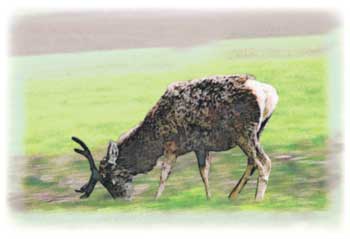
A red deer in velvet
The familiar cycle of annual antler regeneration in deer is in fact a unique phenomenon among higher vertebrate animals. Although all mammals possess the ability to heal wounds, complete regeneration of an organ takes place in no other mammal. This means that each year the entire structure (including all its supportive blood vessels, nerves, skin, hair and sebaceous glands) appears, grows very rapidly at up to 2 cm/day, and then calcifies. After the support structures regress, and the skin peels off, a hard bone structure remains, which itself will subsequently be discarded by the stag and replaced. So, velvet antler has some unique and interesting qualities, particularly its very fast growth rate and the fact it fully regenerates each year. Together these might predict why deer velvet has health promoting value.
Deer velvet which is available today as a health food or dietary supplement is produced from domesticated deer which are kept solely for deer velvet production, on well managed farms. Each year, the growing antlers of the deer are removed, under veterinary supervision and with careful application of pain relief. This technique was developed and approved in New Zealand by the Animal Welfare Advisory Council which is a group of animal welfare advocates and government representatives. In New Zealand the removal of antlers takes place about 50-55 days after casting of the previous hard antlers, which is about half way through the period of normal growth. After removal, the antlers are frozen prior to processing (drying) in a New Zealand Government Inspected Facility. The antler loses about 65-70% of its water content during this process. The resultant product is dried deer velvet. Although we sometimes use the word 'velvet' alone this is perhaps misleading as some people think that this is simply the soft outer skin, when in fact the health food product is produced from the whole 'stick' of growing antler. Deer velvet is therefore the bone cartilage and skin of the rapidly regenerating antler.
Deer velvet has been known to be beneficial for health for more than 2000 years. Silk scrolls found in a Chinese tomb in 168BC clearly documented deer velvet as a part of the Chinese medical pharmacopoeia. In fact deer were often associated with the Chinese God for Longevity. We have speculated that even in pre-historic times people may have marvelled at the rapid growth and regeneration of antlers. Perhaps they ate them after the animal was hunted and experienced some of the health benefits. It would be a short step to specifically removing and preserving the antlers for the collection of natural medicines. It seems strange to us in Western countries to think of deer velvet as a herbal medicine, because we do not associate animals parts with therapeutic value. This is no enigma to the Traditional Chinese Medical (TCM) practitioner, however, who accepts a wide range of plant, animal and mineral ingredients for their armoury of health products.
By 1596 AD deer velvet was well established in TCM. In that year Li Shi-Zhen wrote his famous text Grand Materia Medica. He described deer velvet as a 'herb' (animal and plant parts are treated the same in TCM) which tonified the Yang and listed the following functions:
- increases vital forces
- boosts the will
- strengthens the muscles and bone
- cures general debility
- reduces the effects of rheumatism
- prevents osteomyelitis
- stops uterine haemorrhage
- delays senility
- prevents male impotence.
Deer velvet has continued to be an important part of the TCM pharmacopoeia to the present day. The current uses listed in the TCM books are:
- as a cure for systematic exhaustion via effects on
- adrenal cortex function
- energy metabolism
- growth
- disease resistance
- to increase resistance to cold
- to increase cardiovascular function
- to improve strength and decrease fatigue
- to increase red and white blood cell numbers
- to aid in wound healing
- to improve immune function
- as a diuretic
- as an anti-ageing treatment.
This list seems to be rather broad and perhaps overly exhaustive and excessive. From a Western concept of specific drugs and specific functions it seems to be impossible. But curing exhaustion, strengthening resistance to disease and improving strength could all be explained by active substances in the velvet associated with rapid growth and its control. Factors in the antler responsible for rapid nerve and blood vessel development might explain the cardiovascular and cold resistance functions. Finally the anti-ageing effects could be due to substances involved in ensuring that the rapid processing of cell division occurs in an orderly pattern, given that a major effect of ageing is a break- down in cellular metabolism leading to poor tissue maintenance and 'mistakes' in cell division. Thus it may be possible to group velvet antler effects into restoration/ regeneration, neuro-vascular and anti-ageing functions. The restoration/ regeneration category can be sub-divided further into subcategories of tissue repair (return to a normal state) and performance enhancement (improvement of the existing state).
In the 1930s an alcohol extract of deer velvet was developed in Russia. This is referred to as Pantocrine and was sold as a liquid. It contains largely the lipid (fat) components of velvet. Russians carried out a series of pre-clinical trials using animals and also extensive clinical evaluation of Pantocrine. This research closed in the 1960s. Some key results are referred to below in the section on Health Benefits.
Asians typically purchase deer velvet from a Traditional Medicine Doctor, who will prepare a prescription of deer velvet together with many other natural medicines. The deer velvet will be cut into thin slices from a whole velvet stick prior to use. The prescription will be taken home by the patient and a soup will be prepared. The soup will be taken hot. In Western countries deer velvet is available in either of two convenient-to-take forms, powder or extract. Deer velvet powder is simply the processed whole antler stick ground to a fine powder and encapsulated. Deer velvet extracts are made by mixing deer velvet powder with water or alcohol and filtering out the residue. The water extracts contain mainly protein and some polar lipids and the alcohol extracts (like the Russian Pantocrine) contain polar and non polar lipids. The extracts can be dried and encapsulated or can be incorporated into a variety of foods and beverages as functional ingredients.
Health Benefits Shown by Research
In discussing the health benefits from velvet, I will use the application categories I described above.
Restoration/Regeneration – Tissue Repair/Healing
Deer velvet has been shown to have a number of key functions which can loosely be grouped as restoring an organism which had been subject to illness or injury to its former state. I will first discuss deer velvet's effect on osteoporosis and its anti-anaemia action.
Osteoporosis
Osteoporosis is a disease primarily of old age, mainly in women. The bones progressively lose mineral making them prone to fractures. Osteoporosis significantly worsens after menopause primarily due to a reduction in the ovarian hormone, oestrogen.
A useful clinical model in which to study osteoporosis is the female rat with the ovaries removed. Such ovariectomized rats rapidly loose bone density. This effect can be reversed by the administration of synthetic oestrogen. Ahn et al (1994) studied the effects of administration of a water extract of New Zealand deer velvet to ovariectomized rats. This work showed that ovariectomized rats treated with deer velvet retained more mineralised bone than control ovariectomized rats which were not treated with deer velvet. In a follow up study, also using a water extract of New Zealand deer velvet, bone density was measured in ovary intact control rats, and rats which had been ovariectomized and treated orally with either deer velvet or saline (Shim and Ahn 1999). The results are shown in Table 1. The deer velvet effectively maintained bone density after ovariectomy at a level close to that of the ovary intact control rats. In contrast bone density fell in the ovariectomized rats which were not treated with deer velvet.
|
Table 1 Effects of a water extract of New Zealand Deer Velvet on the density of the tibia in rats. Mean ± standard error of the mean |
|||
| Intact Control | Ovariectomized |
Ovariectomized + |
|
| Density | 1.49 ± 0.04 1.39 ± 0.02* |
1.46 ± 0.06
|
|
| * significantly different to controls, p<0.05 | |||
As deer velvet does not contain appreciable amounts of oestrogen, this product presents an opportunity to protect the skeleton against the type of osteoporosis seen in post menopausal women without the side effects typical of hormone replacement therapy.
Anaemia
Kim et al (undated) studied the influence of water based extracts of velvet from NZ red deer, on erythrocyte numbers and blood haemoglobin (Hb) levels of rabbits with experimentally induced anaemia. The worst anaemia was evidenced on day 4, and on that day and for the next 12 days 250 mg/kg of antler extract was administered to each rabbit.
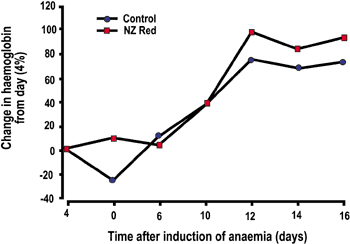
A group of control rabbits was made anaemic but received no further treatment. The data are presented as percentage changes relative to day 4. Haemoglobin levels (Figure 1) improved in all groups, including the control. The rate of improvement was greater for the group receiving an extract of NZ red deer velvet. Likewise, percentage improvement of erythrocyte numbers was higher for the red deer velvet group compared with the control (Figure 2).
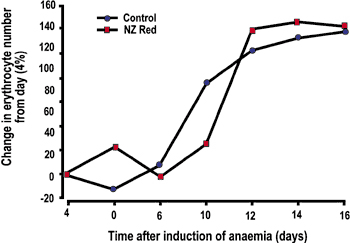
These results show a strong anaemia alleviating effect. Although the factors responsible are unknown, there is clear evidence that a component in velvet antler can alleviate experimentally induced anaemia, thus clearly demonstrating a restorative function.
Performance Enhancement
Sports people, whether professional or amateur, continuously strive to improve physical performance. The disciplines of sports medicine and sports nutrition have arisen from the need to develop combined training, injury treatment and nutritional programmes to permit the best possible athletic performance.
Velvet antler is exquisitely placed to impact on sports medicine and nutrition. Velvet antler could be used as a training aid, a performance booster, a recovery promoter after physical activity, a treatment for injury and possibly an injury preventative. These possibilities are consistent with velvet's use as a food and not necessarily a pharmaceutical.
Velvet antler could improve athletic performance by increasing strength, endurance (stamina), increasing oxygen carrying capacity of the blood, repairing minor tissue damage occurring either during training or in a competitive event and by boosting the immune system of athletes whose immune system has been compromised during extreme exertion. Many of the above can be rationalized as examples of the protective or healing efficacies of velvet antler.
Taneeva (quoted by Brechman, undated) tested the effect of alcohol velvet antler extract in athletes running 3000 m races. 50 men aged 18-23 years ran 3000 m and the time each took to complete the event was recorded. A single administration of 20 ml velvet antler extract 30 minutes before the next race lowered the average time to complete the event from 14 minutes 48 seconds to 14 minutes 4 seconds. In a second experiment the alcohol velvet antler extract was administered for 12 days and the race was re-run 24 hours after the last treatment. The time taken to complete the event was reduced in the majority of subjects. Interestingly, improvement was noted in runners who were in the top middle or the lower categories of the group in terms of initial performance. That is, alcohol velvet antler extract improved the performance of both above average as well as below average athletes.
A collaborative trial was recently carried out by AgResearch Invermay and the Human Performance Centre at the University of Otago in Dunedin. The aim was to determine whether treatment with NZ velvet antler powder could enhance gains in strength made as a result of specific training in male athletes.
34 male volunteers were randomly allocated to a daily dose for 70 days of either 1.5 g/day NZ deer velvet powder (n=17) or an inactive placebo control (n=17), in a double blind trial. During the treatment period the volunteers trained their upper leg muscles 3 days each week using isoinertial training equipment and an isokinetic dynamometer (Biodex, NY). The muscular strength and endurance of the volunteers was tested twice pre-training and twice after the 70 days of training. Five subjects from each group pulled out part way through the experiment, for reasons not associated with their allocated treatments.
The major finding of the study was that isokinetic strength and muscular endurance improved to a significantly greater extent in the group treated with NZ deer velvet as compared to the placebo group (Table 2). Strength was taken as the maximum torque generated during 3 maximal voluntary contractions (MVCs) on the isokinetic dynamometer at an angular velocity of 60 deg/s. Muscular endurance was determined using a similar protocol, but was measured as the average torque generated over 25 MVCs at an angular velocity of 120 deg/s. The improvement was specifically observed during leg extension exercises on the isokinetic dynamometer, and consequently involved the quadriceps muscle. This movement was specifically trained during the study.
Strength was also assessed using an isoinertial parallel squat exercise. The maximum weight subjects could lift six but not seven times (six-repetition maximum) was tested on a Smith machine. In this case, although the amount of weight lifted increased slightly more after the training period for the deer velvet treated group than the placebo group (Table 2), the difference was not significant. Similarly, there was no difference between groups in a 90 second cycle ergometer sprint test of endurance (data not shown).
|
Table 2
Effects of powdered New Zealand Deer Velvet on the improvements in muscular strength and endurance of male athletes following a 10 week training period. Peak torque and average power are indices of isokinetic strength and muscular endurance respectively. Six-repetition maximum is a measure of isoinertial strength. See text for the protocols used to obtain these values. Data presented are means ± standard deviation. |
|||
| Measure | Value | Control | NZ Deer Velvet |
| Peak torque (Nm) | Pre-training Improvement |
265 ± 50.7 34.4 ± 34.1 |
23 ± 47.3 62.1 ± 35.7* |
| Average power (Watts) | Pre-training Improvement |
222 ± 44.1 13.8 ± 26.4 |
20 ± 47.2 38.9 ± 22.1* |
| Six-repetition maximum (kg) | Pre-training Improvement |
87.9 ± 26.8 31.4 ±14.5 |
79.6 ± 17.1 34.0 ± 12.9 |
| * significantly different to control group, p<0.05 | |||
This study suggests that deer velvet is able to augment the gains in muscular strength and endurance that result from specific training of muscle groups. Although not providing a mechanism for the effect, the trial provides a solid basis for future investigations of deer velvet's potential role as a physical performance enhancer.
Another collaborative trial recently carried out by AgResearch Invermay and the University of Otago investigated the possibility that NZ deer velvet might assist athletic performance by protecting against, or speeding recovery from, muscle damage.
In this double blind experiment, subjects received a daily dose for 14 days of either 1.5 g/day NZ deer velvet powder (n=8) or an inactive placebo control (n=6). They were then subjected to an eccentric exercise (30 minute downhill run) designed to induce mild ultrastructural damage to the quadriceps muscle. Blood samples were obtained before and 96 hours after the eccentric exercise for measurement of creatine kinase (CK), lactate dehydrogenase (LDH) and aspartate amino transferase (AST) as serological markers of muscle damage. Muscle biopsies were also taken and were examined using a transmission electron microscope for degree of ultrastructural damage. In addition, subjects were asked to rate their degree of muscle soreness on a scale of 1 (normal) to 10 (very sore), at daily intervals for four days following the eccentric exercise. Daily consumption of either NZ deer velvet or placebo continued throughout this post-exercise testing period.
Treatment with NZ deer velvet significantly lowered the increase in CK caused by the muscle damaging exercise. The mean increase in CK of the NZ deer velvet treated group was only 11%, as compared with 95% for the control group. AST also increased less in the NZ deer velvet treated subjects than in the controls (5% and 21% increases, respectively), but the difference was not statistically significant. LDH levels rose by an average of 7% in the control group, as against a slight decrease (2%) in the NZ deer velvet-treated group, but again the difference was not significant. A trend also emerged in the subjective muscle soreness rating data (Table 3). On average, subjects taking NZ deer velvet reported a return to essentially normal levels of muscle soreness (soreness rating below 2) 24 hours before subjects in the control group. No evidence for an effect of deer velvet on the degree of ultrastructural muscle damage was found, though, by electron microscope examination, and no mechanism for the effect on CK levels was able to be postulated from the results of the experiment.
|
Table 3
The effects of powdered New .Zealand Deer Velvet on the subjective muscle soreness ratings of athletes at times following a 30 minute period of eccentric exercise. These were reported on a scale of 1 (normal) to 10 (very sore). On this scale, a score of 3 corresponded to “slightly sore” and 5 to “moderately sore”. Data presented are means ± standard deviation. |
||
|
Time Following Exercise
|
Control
|
NZ Deer Velvet
|
|
0 hours
24 hours 48 hours 72 hours 96 hours |
2.8 ± 0.8
4.3 ± 2.2 4.2 ± 2.6 2.5 ± 1.5 1.4 ± 0.5 |
3.4 ± 1.3
3.9 ± 2.2 3.8 ± 1.4 1.6 ± 0.7 1.3 ± 0.5 |
These results add scientific weight to the anecdotal evidence provided by a number of top New Zealand athletes (http://www.velvet.org.nz/), who claim that NZ deer velvet enhances their recovery from training and competition. On balance, the results are certainly supportive of a positive effect of NZ deer velvet on prevention or repair of muscle damage following exercise, even though the mechanism is unclear at this time.
Neuro-Vascular Function
In the Russian literature there are many studies in which neuro-physiological experiments have been carried out to determine the tissue responses to Pantocrine. It is outside the scope of this review to detail these but the overwhelming conclusion is that there are active ingredients in velvet antler which act on peripheral nerve endings. These may well control the hypo- and hypertensive effects and be responsible for the vaso-dilation which causes the nose bleed and 'warming' side effects of velvet antler that have been reported.
Blood Pressure
The Russian clinical literature contains apparently paradoxical references to the use of alcohol extract of deer velvet for both the reduction and raising of blood pressure i.e. hypo- and hypertensive functions. Although active components are not fully characterized, we consider this paradox is evidence, in part, for a homeostatic restorative function. Albov et al (1969) studied 32 patients with high blood pressure (hypertension) caused by cardiac disease, early onset menopause or obesity. They were treated with alcohol extract of deer velvet either orally or by injection for 20 or 30 days respectively and then examined by a physician. Twenty six of the patients (81%) had measurably lower blood pressure and reported an improvement in condition. Those reporting no improvement had had high blood pressure for an extended period of 9-10 years.
The same authors also studied the effects of alcohol extract of deer velvet on 13 patients with hypotension caused mainly by disorders of heart muscle activity. The patients were given 20 daily injections of Pantocrine and were examined 10 days after the final treatment. Eleven of the patients (84%) showed an improvement.
Dose levels in both studies were one ampoule/day (2 ml) by injection, or 30 drops (about 4.5 ml) orally three times a day. Mainly female patients were studied but successful treatment of some men was also reported. In the women treated for premature menopause, menses resumed in most. On balance it must be stated that data from untreated control people were not presented. Consequently no scientific evaluation of this finding is possible and the results are presented for information only.
How can alcohol extract of deer velvet apparently have opposite effects at the same time? Arguably there are different active ingredients present, that act together in a balanced fashion. The overall effect is thus that velvet 'treats' the abnormality and 'returns' it to the normal level, thereby raising or lowering blood pressure.
This enigma prompts us to advise that persons with either extremely high or low blood pressure should avoid the use of deer velvet.
Anti-Ageing
Wang Ben-Xiang et al (1988a, b) studied the effects of velvet antler extracts on the ageing process using a special breed of mouse which had been selected for its propensity to exhibit early senility. They showed that velvet antler increased testosterone in male mice, and decreased the activity of enzymes associated with the ageing process. In addition, velvet antler extract raised levels of liver superoxide dismutase, a free radical scavenging enzyme. Velvet antler extract also increased liver and kidney protein synthesis by enhancing enzyme activity. Taken together the data are powerful evidence of an anti-ageing effect of velvet.
We consider that these diverse effects of velvet antler extract on the ageing process could, in part, be due to substances produced in the velvet during growth which act to maintain the integrity of cell multiplication. While velvet is growing rapidly, errors of cell division, and possibly protein synthesis, may occur frequently unless some system is in place to control and minimize the potentially deleterious consequences of such errors. We present this speculation as a theory to explain the anti-ageing phenomenon.
Safety
As with all dietary supplements product safety is of paramount importance. We have studied acute and sub-chronic toxicity of powdered deer velvet at a dose level of 2000 mg/kg in a single oral treatment and 500 mg/day orally for 90 days respectively in rats. There were no pathological findings. In a subsequent study we have tested the effect of orally administered deer velvet powder on reproduction and developmental toxicity. Deer velvet powder had no effect on conception rate in pairs of rats in which both sexes were treated compared with untreated pairs. The pregnant females gave birth normally to normal pups and lactation was established irrespective of whether they were treated with deer velvet powder or were untreated controls.
Composition
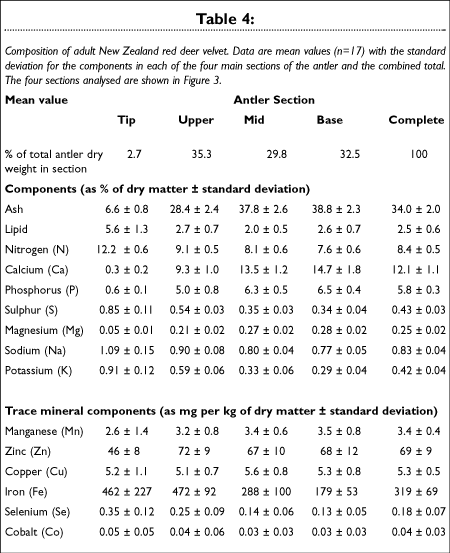
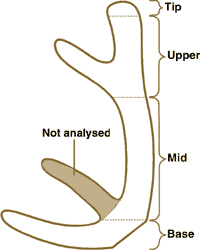
The fat and mineral analysis of red deer velvet antler is shown in Table 4. The velvet antlers from 17 stags were processed and analysed using standard laboratory procedures. For analysis the antlers were separated into four major portions (tip, upper, mid and base) (Figure 3). These portions differ in their chemical composition and indeed used by practitioners of Traditional Chinese Medicine for different functions. Broadly lipid and protein (nitrogen x 6.25) decrease from the tip to the base and ash and calcium increase. This reflects the fact that mineralization of the velvet antler from the initial matrix of cartilage increases from the base to the tip. As most of the active ingredients of velvet (see below) are likely to be proteins or lipids this explains why upper parts of the velvet are more heavily prized for their efficacy.
Dose
Deer velvet capsules which are available in the West typically contain 250-350 mg. Although no dose-response work has been published to date from clinical studies, there is a groundswell of opinion among users that one capsule/day is sufficient to maintain health and alleviate minor fatigue. In contrast for healing or performance enhancement (to return a person to a balanced position or improve a person to a higher equilibrium) higher doses are used. We have successfully used 1.5 g/day but even higher doses – up to 9 g/day are used by TCM doctors for brief periods of up to 10 days.
Some minor side-effects have been noted at higher dose levels. These include headaches and nose bleeds. Many people who take higher doses of deer velvet feel warm – and indeed Korean people deliberately take deer velvet in winter to take advantage of this effect.
Active Ingredients
Relatively little research has taken place on the active ingredients found in deer velvet. Wang et al (1990a and b) have isolated polyamines which increase protein synthesis in the livers of mice. A number of growth factors have been shown to exist in deer velvet including epidermal growth factor (Ko et al, 1986), insulin like growth factors I and II, transforming growth factors a and b, (Francis and Suttie, 1999) and neurotrophin-3 (Garcia et al, 1997). Wang (1996) lists a number of phospho- and glycolipids which influence blood pressure and monoamine oxidase activity.
As deer velvet has a wide spectrum of human benefits it is very unlikely that there is one single active ingredient. Rather there are likely to be several which may interact with each other in a complex way as is often the case with natural health promoting agents.
Conclusion
Deer velvet is an ancient health product that has been revived with the global up swing in the international use of natural health products, assisted by the increase in deer farming. Working from the basis of TCM philosophy, deer velvet is a healer or restorer and at certain doses a performance enhancer. Clinical evidence in the West is at an early stage, but support is mounting that deer velvet is a safe natural health product. In the future, research currently being undertaken on arthritis and ulcer healing will no doubt lead to another range of products with the ability to safely, and positively enhance human health.
References
Ahn DK, Kim Ho Cheol and Choi Ho Young. Effects of the Cervi Parvum Cornu on the aged ovariectomized rat model of post-menopausal osteoporosis. International Symposium on Cervi Parvum Cornu, Seoul, Korea. The Korean Society of Pharmacognosy, pp 65. 1994.
Albov NA and Krupernikov LF. The influence of Pantocrine on menopause. In S.M. Pavlenko (editor) Pantocrine. A Publication of Articles on Studies of the Curative Properties of in Pantocrine. Sojuzchimexport, Moscow, USSR, 26-40. 1969b.
Albov NA, Borovskaya VA and Kofanav IF. Clinical observations on the influence of Pantocrine on cardiac patients. In S.M. Pavlenko (editor) Pantocrine. A Publication of Articles on Studies of the Curative Properties in Pantocrine. Sojuzchimexport, Moscow, USSR, 21-26. 1969a.
Brechman II. Pantocrine. Medexport, Moscow, USSR. Undated.
Francis SM and Suttie JM. Detection of growth factors and proto-oncogene mRNA in the growing tip of red deer (Cervus elaphus) antler using reverse-transcriptase polymerase chain reaction (RT-PCR). The Journal of Experimental Zoology 281: 6-42. 1998.
Garcia RL, Sadighi M, Francis SM, Suttie JM and Fleming JS. Expression of neurotrophin-3 in the growing velvet antler of the red deer Cervus elaphus. Journal of Molecular Endocrinology 19: 173-182. 1997.
Kim KL, Shin MK, Lee HI, Kim WH and Lee SI. Effect of several kinds of antler (Cervi cornu) on the erythrocytic activity in experimentally induced anaemic rabbits. Samwon Commercial Company, Korea Trading Agents Associations, Seoul. Undated.
Ko KM, Yip TT, Tsao SW, Kong YC, Fennessy P, Belew MC and Porath, J. Epidermal growth factor from deer (Cervus elaphus) submaxillary gland and velvet antler. General Comparative Endocrinology 63: 431-440. 1986.
Shim SD and Ahn DK. Effects of Cervi Cornu on the aged ovariectomized rate model of postmenopausal osteoporosis. Korean Journal of Herbal Medicine 14:153-166. 1999.
Suttie JM, Fennessy PF, Haines SR, Kerr D, Sadighi M and Isaacs C. The New Zealand velvet antler industry: Background and research findings. Proceedings of the Korean Symposium on Velvet Antler, Korean Society of Pharmacognosy, 86-151. 1994.
Wang, Ben-Xiang (1996). Advances in the research of chemistry, pharmacology and clinical application of pilose antler. Proceedings of the '96 International Symposium on Deer Science and Deer Products. Changchun, China, 14-32. 1996.
Wang, BX, Zhao XH, Qi SB, Kaneko S, Hattori M, Mamba T and Nomura Y. Effects of repeated administration of deer antler extract on biochemical changes related to ageing in senescence-accelerated mice. Chemical and Pharmaceutical Bulletin 36: 2587-2592. 1988a.
Wang, BX, Zhao XH, Qi SB, Yang XW, Kaneko S, Hattori M, Mamba T and Nomura Y. Stimulating effect of deer antler extract on protein synthesis in senescence-accelerated mice in vivo. Chemical and Pharmaceutical Bulletin 36: 2593-2598. 1988b.
Wang, Ben-Xiang, Chen H., Xu W., Zhang W and Zhang J. Effect of polyamines isolated from pilose antler on RNA polymerase activities in mouse liver. Acta Pharmaceutica Sinica 25: 652-657. 1990.
Wang, Ben-Xiang, Chen X. and Zhang W. Influence of the active compounds isolated from pilose antler on synthesis of protein and RNA in mouse liver. Acta Pharmaceutica Sinica 25: 321-325. 1990.
Further Information
Deer Velvet is available in the UK from Velvet Energy UK Limited. Tel: 01327 844777; Fax: 01327 844618.
Comments:
-
Antler Farms said..
Great summary on the clinical studies performed on deer antler velvet.
http://www.antlerfarms.com